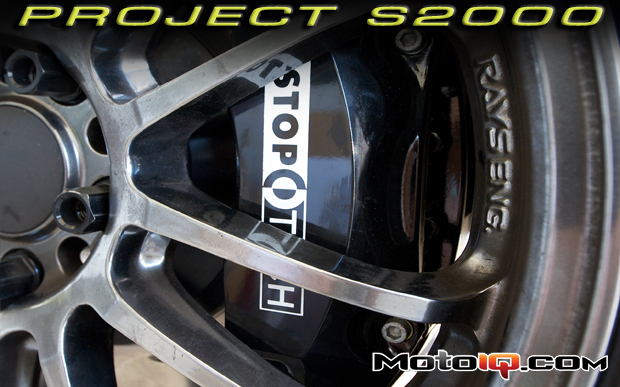,
 |
| The StopTech Aerorotor’s directional vanes are shown here. The rotor is float mounted on the alloy hat to prevent distortion and warping. |
Reduced deltaT is important because of another material property: materials expand and contract as they change temperature. This is a pretty simple equation: change in length = deltaT X coefficient of thermal expansion. Every material has a coefficient of thermal expansion which says how much longer/shorter it will get with a change in temperature. A lot of expanding and contracting fatigues a material; think of bending a paperclip back and forth until it snaps. However, in this case, we’re putting in and taking out heat a bunch of times causing it to grow and shrink, which fatigues the rotor and that leads to cracks.
 |
| You can see the vanes on StopTech’s Aerohat. The vanes pump air between the hat and rotor to help keep this area cooler reducing heat transfer to the hub. |
Another key feature of the StopTech rotor is their directional vanes. The directional vanes induce greater cooling air flow (as compared to the stock straight vanes) through the rotor which reduces its deltaT. Why does the stock rotor use straight vanes? Because it’s cheaper as you only need one design of rotor for both sides of the car and therefore only one casting tool. With directional vanes, you need unique left side and right side rotors which mean greater manufacturing costs. Another indirect benefit, the directional vanes tend to interrupt the propagation of radial cracks, making for an inherently more durable part than the stock, straight-vane rotors.
 |
| To install the brakes you have to remove the factory dust shields. Removing the dust shields requires vise grips and aviation/tin snips. I used needle nose vise grips to unscrew the three screws holding on the dust shield; there’s not enough space to get a Phillips head screw driver on them, so you have to grab the screw heads with the vise grips. Once the screws are out, make a few strategic cuts to remove the dust shields. |
To offset the added mass in the pad contact area, the center of the StopTech rotor (the rotor hat) is aluminum, shaving pounds off the rotor. Even though the StopTech rotor is significantly bigger, it’s still lighter than the stock rotor which is completely cast iron. This is not just a plain aluminum hat however, but StopTech’s patented AeroHat. The AeroHat uses some raised directional geometry to increase airflow to the outside rotor face, further increasing cooling.
 |
| Dust shields gone and ready to install stuff. |
Stoptech two-piece floating rotors with aluminum hats allow the cast iron rotor to expand radially relative to the aluminum hat, minimizing the thermal stress and coning that can happen in one piece and solidly bolted two-piece rotors. The difference in temperature between the hat and rotor with a one-piece cast or solidly bolted on hat can cause the rotor to assume a cone shape at high temperatures. This leads to uneven taper wear of the pads, causing a soft pedal as the pads wear. Floating rotors for street cars include Inconel spring washers to prevent the rotor and hat from rattling over bumps. For race cars, StopTech uses rotor hardware that allows free axial float as well, which reduces piston knockback caused by hub and bearing flex under high cornering loads. When it comes time to replace the rotors, only the outer steel ring needs to be replaced. The aluminum hat is reused, reducing costs.



